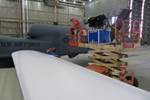NCMS report features multi-sector collaborations achieving composites, advanced materials breakthrough
The Technology Brief, “Breakthroughs in Composites and Advanced Materials Sustainment” reviews several successes in advancing high-performance composite design and manufacturing processes.
The National Center for Manufacturing Sciences (NCMS, Ann Arbor, Mich., U.S.) announces the publication of a new report focused on advancing high-performance composite design and manufacturing processes through its collaborations with industry, academic and government partners.
For decades, NCMS says it has facilitated initiatives resulting in remarkable advancements in the use of composites and other advanced materials. In its most recent Technology Brief, “Breakthroughs in Composites and Advanced Materials Sustainment,” it reviews several successes, including:
- An NCMS initiative solved a challenge in the production and repair of composites. NCMS says more than 10% of engineering time is spent resolving cure cycle and heat transfer issues. The project team developed and validated the effectiveness of tools to manage heat transfer for ovens and autoclaves used in the production and repair of composites. Higher quality repair of composite structures results in fewer failures and therefore fewer scrapped parts, more efficient operations and significant cost savings.
- To solve the difficulties many maintenance artisans face in joining together lightweight composites and alloys, NCMS partners have found success in developing high-strength, high-elongation adhesives with low-temperature cure times. Given the increased use of advanced lightweight materials in the automotive, aviation and aerospace industries, these more versatile joining methods for dissimilar materials are critical for manufacturing and repair.
- A team of academic and industry partners has developed a reversible thermoplastic adhesive system capable of repairing vehicle components comprised of a combination of steel, aluminum and glass fiber-reinforced composites. Being able to remove and replace advanced adhesives quickly and easily greatly reduces the downtime and cost for repairing a wide range of assets in many industries, NCMS says.
- Another multi-sector initiative is developing a domestic source of mesophase pitch-based carbon fiber and lightweight composites to produce lightweight composite wheel rims and other components for commercial and military trucks. According to the company, it is critical that more local, affordable sourcing for carbon fiber be developed as the need grows for lighter weight, more fuel-efficient vehicles and equipment.
In addition, NCMS has worked for several years to facilitate an annual meeting of the Joint Composite and Advanced Materials Sustainment (JCAMS) group established by the Department of Defense (DOD). This meeting continues to bring together government and military officials, industry leaders, manufacturers, engineers and other technical experts who focus on issues facing the manufacturing, tooling, deployment and repair of advanced composite materials in a defense setting.
To learn more about these and other successes as well as NCMS’s role in developing, demonstrating and transitioning innovative technologies, view the full Technology Brief here.













